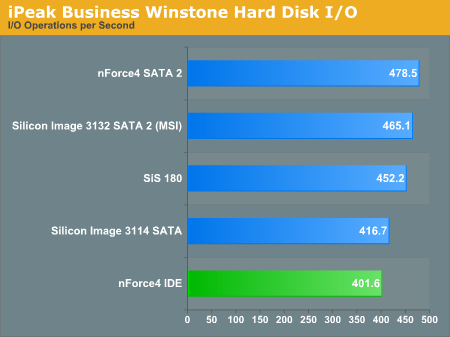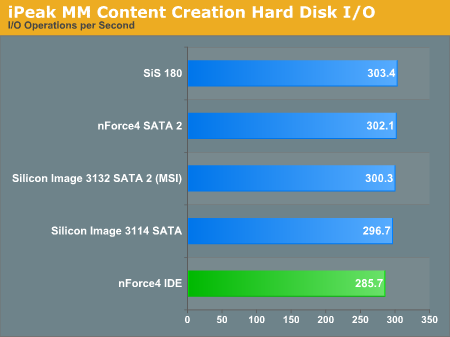nForce4 Ultra Roundup: Charting the Mainstream
by Wesley Fink on July 5, 2005 10:28 PM EST- Posted in
- Motherboards
Disk Controller Performance
With so many storage controllers on the nForce4 SLI boards, we needed a means of comparing performance of the wide variety of controllers. The logical choice was Anand's storage benchmark first described in Q2 2004 Desktop Hard Drive Comparison: WD Raptor vs the World. To refresh your memory, the iPeak test was designed to measure "pure" hard disk performance, and in this case, we kept the hard drive as consistent as possible while varying the hard drive controller. The idea is to measure the performance of a hard drive controller with a consistent hard drive. We played back Anand's raw files that recorded I/O operations when running a real world benchmark - the entire Winstone 2004 suite. Intel's IPEAK utility was then used to play back the trace of all the IO operations that took place during a single run of Business Winstone 2004 and MCC Winstone 2004. To try to isolate performance difference to the controllers that we were testing, we used Seagate 7200.7 model SATA and IDE hard drives for all tests.iPeak gives a mean service time in milliseconds; in other words, the average time that each drive took to fulfill each IO operation. In order to make the data more understandable, we report the scores as an average number of IO operations per second so that higher scores translate into better performance. This number is meaningless as far as hard disk performance is concerned as it is just the number of IO operations completed in a second. However, the scores are useful for comparing "pure" performance of the storage controllers in this case.


The Silicon Image 3114 controller is only a bit slower in MM Content IO, but it quite a bit slower in Business IO. The 3114 does uniquely feature RAID 3 capabilities.
IDE provided the slowest IO performance in this roundup, demonstrating that SATA controllers are finally starting to show a performance edge - at least in IO operations.
We also plan to include IDE RAID and SATA RAID benchmarks in future motherboard tests. Comparing RAID performance on various controllers will definitely be a part of future storage benchmarking and possibly motherboard tests as well as new on-board RAID controllers that are introduced.










75 Comments
View All Comments
arfan - Wednesday, July 6, 2005 - link
"So ECS, Foxconn, Biostar - we can only suggest that you need to add features and performance that will make an AMD user want to buy your boards. "Why u think's ECS is bad ???
From your benchmark, ECS is not too bad, their ranking in the middle until top1.
Sorry, if myenglish is so bad.
smn198 - Wednesday, July 6, 2005 - link
Page 1: "There are no performance differences in the SLI and Ultra chipsets, or even the base nForce4 for that matter. These chipsets differ only in which features are available to the buyer - but they beat with the same heart."I thought the base nForce4 had a 800MHz HT where as the Ultra and SLI have 1GHz. Is that not correct?
Frallan - Wednesday, July 6, 2005 - link
For PSU requirements read the mfg websites. Especially the DFI comes with explicit requirements.480W 24pin ATX 2.0+ PSU and from experiance Id have to say that U want a 1st tier PSU on top of that. Anecdotal advices that its possible to run a DFI SLI set up overclocked from a 350W PSU exists but fact remains that a good solid 500W+ ATX 2.0+ PSU will help U with stability.
Calin - Wednesday, July 6, 2005 - link
What I want to ask: does the processor works with four DS DIMMS at 1T command rate at lower frequency? By what you say (that 2T command rate is much slower than 1T command rate), then 1T command rate at 333MHz would be faster than 2T command rate at 400MHz.Vesperan - Wednesday, July 6, 2005 - link
I love the look of that Epox board. Pity noone imports Epox products into New Zealand any more.GhostlyGhost - Wednesday, July 6, 2005 - link
Ermm.. It's "Marvell". With two l's.Heidfirst - Wednesday, July 6, 2005 - link
I think that you must have a bad example of the ABIT. A no. of other sites (HardOCP, Hexus etc.) have all been over 300 ref. clock with it.Not to mention that there is also now the non-Fatality AN8 Ultra which is cheaper & yet has better sound & 3.55Vdimm instead of 2.8V on the Fatality ...
Affectionate-Bed-980 - Wednesday, July 6, 2005 - link
I think the Neo4 should've been included even though it was in the SLI test. Same with the Asus board. Those are really important boards. I'm sure if you add up the Asus and MSI users they would outnumber Biostar + Foxconn + Chaintech + ECS. Iono. just my 2 cents. I dont want to go look at the SLI review and then compare it to this review to see other boards and do a mental benchmark merge to get hte relative performance.You know what we should make? We should make the uber super chart system. Kinda like THG's CPU charts. Just make the interactive system comparation machine. Choose a CPU, a mobo, a gfx card etc. If you bench every component (not every combo), but just CPUs vs CPUs, mobos vs mobos, you can get the relative score and construct a relative table for combinations..... hmm just a thought.
Palek - Wednesday, July 6, 2005 - link
A few mistakes made it into the final article...-------------------------------------------------
Page 7
1. The following bit does not belong in this review. Cut and paste?
"There are absolutely no PCIe slots at all on the Neo4/SLI except for the pair of x16 slots for SLI video. MSI tells us that the 2nd PCIe can function as a PCIe x1 slot if you're not using it for video, but that is it for PCIe. Does this really matter? Right now, it really isn't important, since we had a very hard time even finding a PCIe x1 LAN card for the new PCI Express. It may matter in the future, but by that time, you will likely have moved on to a newer version of whatever chipset is the latest wonder. This is particularly clear when you look at the feature set of the MSI, since it is definitely a cut above the other boards in this roundup."
2. "SPDIG" should be SPDIF, or S/PDIF if you want to be really accurate.
Page 11
1. The title row of the table is incorrect. The motherboard name should read:
"DFI LANParty UT nF4 Ultra"
2. Link to next page is also incorrect, same as above.
Page 12
1. Title of the page is incorrect, same as above.
2. Title row of the table is incorrect, same as above.
Page 13
1. "SPDIG" round two.
--------------------------------------------------
Also, do guys have any idea why placing the codec on a daughter card reduces CPU overhead? Obviously there is something more going on than just the physical relocation of the chips. Any theories or explanations?
Xenoterranos - Wednesday, July 6, 2005 - link
Just a word about the soundblaster Live on the MSI board..."That price tag [200$] may be a bit high for the average gamer who just spent most of his/her savings on a Pentium II / Voodoo2 setup, however if you're going to swallow the cost of an expensive sound card it might as well be the Creative Labs SB Live!"
That was Anandtech back in '99. And you're getting this for free! (well, almost)